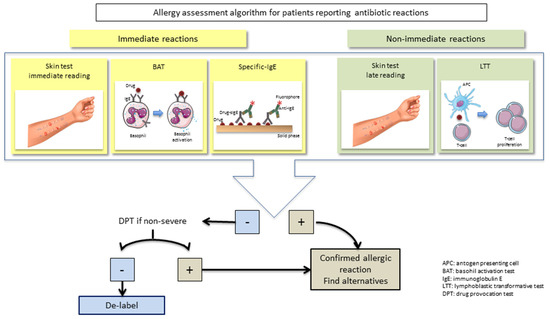Antibiotics 2022, 11(8), 1055; https://doi.org/10.3390/antibiotics11081055
(This article belongs to the Special Issue Combating Antibiotic Resistance with Precision Medicine: The Value of Diagnostic)
Abstract
Antibiotics are one of the most frequently prescribed drugs. Unfortunately, they also are the most common cause for self-reported drug allergy, limiting the use of effective therapies. However, evidence shows that more than 90% of patients labeled as allergic to antibiotics are not allergic. Importantly, the label of antibiotic allergy, whether real or not, constitutes a major public health problem as it directly impacts antimicrobial stewardship: it has been associated with broad-spectrum antibiotic use, often resulting in the emergence of bacterial resistance. Therefore, an accurate diagnosis is crucial for de-labeling patients who claim to be allergic but are not really allergic. This review presents allergy methods for achieving successful antibiotic allergy de-labeling. Patient clinical history is often inaccurately reported, thus not being able to de-label most patients. In vitro testing offers a complementary approach but it shows limitations. Immunoassay for quantifying specific IgE is the most used one, although it gives low sensitivity and is limited to few betalactams. Basophil activation test is not validated and not available in all centers. Therefore, true de-labeling still relies on in vivo tests including drug provocation and/or skin tests, which are not risk-exempt and require specialized healthcare professionals for results interpretation and patient management. Moreover, differences on the pattern of antibiotic consumption cause differences in the diagnostic approach among different countries. A multidisciplinary approach is recommended to reduce the risks associated with the reported penicillin allergy label.



No comments:
Post a Comment